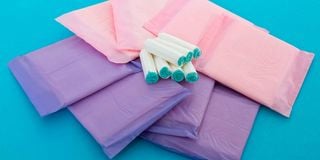Four in 10 Kenyan women cannot afford sanitary towels, shows survey

Sanitary pads.
What you need to know:
- Beyond being a financial burden, the high cost of menstrual products has direct consequences on the safety and dignity of vulnerable populations.
Four in 10 Kenyan women are unable to afford sanitary towels, a new nationwide survey has found.
The survey also reveals that only a tiny fraction (1.62 per cent) finds a packet of pads below Sh50 ‘budget-friendly’, potentially excluding those most in need.
When asked about how much they spend to buy a packet of their preferred sanitary pad brand, most respondents (74.31 per cent) said they buy a packet priced between Sh50 – Sh100, making this the most common price range.
Nearly 19 per cent (18.77 per cent) indicated they pay between Sh101 – Sh150, while a smaller group (4.96 per cent) mentioned spending over Sh150, indicating that some brands remain costly for users.
This is despite the fact that menstrual health is a fundamental human right and key to advancing gender equity not just in the country, but the whole world.
“Nearly half (46.31 per cent) of respondents reported that there are not enough shops in their area selling menstrual products, highlighting a significant accessibility gap.
“The majority of respondents (61.11 per cent ) rate their knowledge and familiarity with menstruation and menstrual products as moderate or somewhat knowledgeable, suggesting a general awareness but potential gaps in comprehensive understanding, ”the survey highlights, adding that over a quarter (25.26 per cent) expressed feeling they are not very knowledgeable, and (2.06 per cent ) reported having no knowledge at all, which was concerning and indicative that there are still challenges in menstrual health education inclusivity and accessibility.
“The results revealed that absorbency (53.24 per cent), comfort (48.26 per cent), and skin sensitivity (44.15 per cent) are the top priorities when choosing menstrual products, outweighing other factors like price, eco-friendliness, adhesive quality and odour control.”
The researchers also disclose that over a quarter (26.84 per cent) of respondents mentioned availability in local shops and the fact that they could not afford alternative menstrual products like cups, tampons, or period panties (12.71 per cent) as reasons they preferred their chosen pad brand.
When asked how many packets they used per menstrual cycle, the majority of respondents (75.4 per cent) mentioned they use between one and two packets, while 14.34 per cent used more than two packets.
Additionally, most respondents (63.41 per cent) believe that the ideal number of sanitary pads per menstrual cycle should be at least 11-20 pads per packet.
The five-month survey done by Nguvu Collective, a global women-led organisation that empowers emerging leaders from the most marginalised communities to drive systemic change -so far with presence in Kenya, Nigeria and South Africa - in partnership with the Kenya Women Parliamentary Association (Kewopa) - aims at improving the government’s sanitary towels programme that is being overseen by the State Department of Gender and Ministry of Education and will further be streamlined when the Provision of Sanitary Towels Bill, 2024 is successful.
“This five-month-long survey, conducted from October 2024 to February 2025, has been supported by Kewopa and nine other local partners. This research work sought to gather the voices of women and girls across Kenya to get their perspectives on what "quality", “affordable”, and "sufficient" mean when it comes to menstrual products, especially sanitary pads,” the findings note while adding that overall, nearly 9,500 responses were gathered from women and girls.
“This study identifies a significant accessibility gap, with more than 45 per cent of respondents reporting that there were not enough shops in their area selling menstrual products. Over 40 per cent of the recipients of the government’s sanitary towels programme report insufficient supply.
“The results further shows that cost remains a barrier to menstrual product access for many, with over four in 10 people struggling with high prices. Additionally, the fact that only a tiny fraction (1.62 per cent) finds a packet of pads below Sh50 budget-friendly signals a gap in budget-friendly options, potentially excluding those most in need,” said the researchers.
The researchers further explain that beyond being a financial burden, the high cost of menstrual products has direct consequences on the safety and dignity of vulnerable populations.
They point out that school-going children, those living in rural areas, and people with disabilities often face the harshest impact - not only struggling with affordability but also becoming more susceptible to exploitation and abuse.
“Cases of transactional sex in exchange for pads, school absenteeism, and the deepening of gender inequalities are common realities for those who cannot afford basic menstrual products. It is therefore important to involve women and girls in defining quality, sufficiency and pricing standards so that policies can be more responsive to their real needs,” they urge while disclosing that an overwhelming 80.7 per cent of respondents agreed or strongly agreed that providing free, sufficient, and quality menstrual products in public spaces would help reduce the risks of violence and exploitation faced by women and girls due to period poverty.
“There was a strong consensus among respondents, with (81.17 per cent) agreement, that the inability to afford or access menstrual products contributes to or directly leads to increased vulnerability to exploitation and abuse.
“It was disturbing to find out that one in three respondents (33.6 perc ent) had personally faced or been at risk of sexual harassment, exploitation, or abuse due to a lack of access to menstrual products while even among those who hadn’t personally been affected, 37.2 per cent said they knew others who had.”
The researchers are of the view that through their findings and recommendations, a powerful impact on policy and product standards should be created, which they say will improve menstrual health outcomes for all girls and women.
“9,480 women and young girls participated in the five-month survey that took place from October 2024 to February 2025,” the researchers noted.
[email protected]


